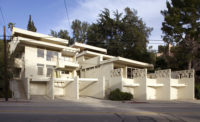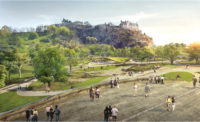This month, the city of Chicago will ring in the sophomore edition of its architecture biennial, the critically acclaimed inaugural event in 2015 having set the stage for the Windy City to become a showcase for architectural innovation.
This year’s theme, “Make New History,” curated by Sharon Johnston and Mark Lee of L.A.-based firm Johnston Marklee, picks up on thematic threads from 2015 while emphasizing site specificity, artistic collaboration, and urban planning. Johnston and Lee have organized a myriad of exhibits, performances, and installations that will radiate from the Chicago Cultural Center (the Biennial’s central hub) to six anchor sites, five partner institutions, and four additional special-project locations. “We’ll see more projects that address the civic landscape—techniques of mapping, studying ways to find new approaches to the civic scale,” says Johnston.
The Chicago Architecture Biennial (CAB), which was the first of its kind in North America, began as part of a sweeping effort by the city to brand itself as a cultural epicenter. It worked: 120 international practices participated, and over half a million visitors passed through the Biennial’s various venues.
But as much as CAB 2017 will attempt to replicate the success of the previous edition, it is largely focused on revitalization, both conceptually and in its commissioned projects. For example, several adaptive-reuse efforts will respond to underutilized spaces. The curators will render the labyrinthine hallways of the Chicago Cultural Center more exhibition-friendly by recreating the arcade-style galleries that Brooklyn firm SO-IL installed for the 2015 Biennial. The Chicago Architecture Foundation, meanwhile, will mount Between States, where 50 Chicago-based designers—ranging from SOM to UrbanLab—have imagined a way to reinvent an underappreciated, underperforming, or dilapidated space in the city.
In keeping with its history-oriented theme, CAB 2017 will plumb the depths of Chicago’s architectural legacy. Notably, in the Cultural Center’s Yates Hall, more than one dozen proposals for a redesign of the historic Tribune Tower will be displayed in the form of 16-foottall architectural models by firms including Berlin-based Kéré Architecture and Zurichand- London-based Sergison Bates architects. The exhibit plays off of two moments in the tower’s history—the original 1922 competition for its design won by Raymond Hood and John Mead Howell, and a 1980 exhibition by Stanley Tigerman and Stuart Cohen, which tasked architects such as Helmut Jahn, Robert A. M. Stern, and Frank Gehry to come up with their own theoretical designs.
In order to continue to elevate the Biennial’s scope to a more global scale (last time, participants represented more than 30 countries), Johnston and Lee have also included national and international projects. Performance artists Gerard & Kelly will present the third part of their choreographic piece Modern Living at Mies van der Rohe’s Farnsworth House, located an hour outside Chicago, while film footage of the first two parts (performed at the Schindler House in California and Philip Johnson’s Glass House in Connecticut, respectively) will be screened at Chicago’s historic Water Tower.
Mies’s structures, both completed and unrealized, will feature prominently in the Biennial: at the Water Tower, James Welling will showcase manipulated photographs of the Illinois Institute of Technology and Chicago’s Lake Shore Drive Apartments. Mies’s work will also appear at the DePaul Art Museum, where a solo exhibition by Mozambican-Portuguese artist Angela Ferreira will establish connections between two unrealized projects on opposite sides of the world: an unbuilt 1913 house in the Netherlands by Mies, and the Zip Zap Circus School in Capetown, designed by Mozambican architect Pancho Guedes.
Also new this year, the Biennial will join forces with the sixth annual EXPO CHICAGO (an international contemporary-art fair at the Navy Pier) in presenting Here Hear Chicago, a collaboration between architect Jeanne Gang and artist Nick Cave. The series of performance pieces will involve participants in Cave’s surreal Soundsuits, interacting with objects designed by Studio Gang.
These sorts of unexpected collaborations will be integral to the success of the 2017 Biennial, says Johnston. “We see this Biennial as a chance to open up opportunities for different kinds of practices and all generations of architects and designers,” she says. “The real strength will be if we can expand audiences and bring architects together.”
The Chicago Architecture Biennial will run from September 16 to January 7.









Post a comment to this article
Report Abusive Comment